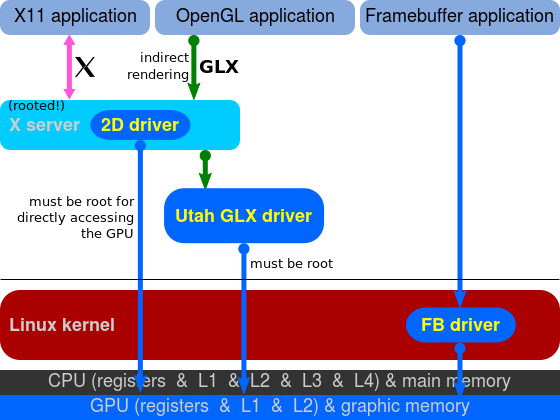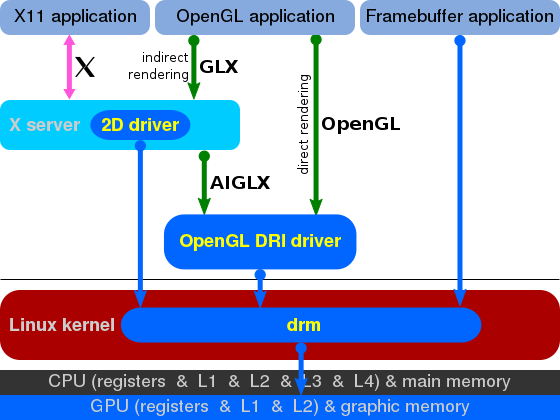2D图形架构
早期Linux图形系统的显示全部依赖X Server,X Client调用Xlib提供的借口向 X Server发送渲染命令,X Server根据 X Client的命令请求向硬件设备绘制图形,X Client与X Server之间通过X11协议通讯。通过这种方式,X Server屏蔽了所有的硬件差异,保证同一个X程序能够在不同的硬件设备上运行。
X Server需要与多种多样的硬件打交道,每个硬件提供自己的DDX驱动程序,X Server最后调用DDX的接口将图形发送给硬件设备。

3D图形架构
通过3D硬件执行3D加速能够大大提高绘制效率,根据不同的模式有两种架构:
Indirect Rendering
这种模式下,仅仅X Server能够访问3D硬件设备,X Client需要绘图时通过X11扩展协议将3D命令发送给X Server,然后由X Server控制3D硬件设备执行,这种模式称为“非直接渲染”。
这种模式与2D模式类似。

但是这种模式无法发挥出3D硬件的效率
Direct Rendering
DRI(Direct Rendering Infrastructure)架构允许X Client直接控制3D硬件设备,所以这种模式下要求X Client与X Server必须位于同一个设备上。
DRM(Direct Rendering Manager)是DRI架构下的Kernel实现,DRM负责:hardware locking, access synchronization, video memory and more.
DRM also provides userspace with an API that it can use to submit commands and data in a format that is adequate for modern GPUs, which effectively allows userspace to communicate with the graphics hardware.
Notice that many of these things have to be done specifically for the target hardware so there are different DRM drivers for each GPU.

DRI/DRM provide the building blocks that enable userspace applications to access the graphics hardware directly in an efficient and safe manner, but in order to use OpenGL we need another piece of software that, using the infrastructure provided by DRI/DRM, implements the OpenGL API while respecting the X server requirements.
Mesa
Mesa is a free software implementation of the OpenGL specification, and as such, it provides a libGL.so, which OpenGL based programs can use to output 3D graphics in Linux. Mesa can provide accelerated 3D graphics by taking advantage of the DRI architecture to gain direct access to the underlying graphics hardware in its implementation of the OpenGL API.
When our 3D application runs in an X11 environment it will output its graphics to a surface (window) allocated by the X server. Notice, however, that with DRI this will happen without intervention of the X server, so naturally there is some synchronization to do between the two, since the X server still owns the window Mesa is rendering to and is the one in charge of displaying its contents on the screen. This synchronization between the OpenGL application and the X server is part of DRI. Mesa’s implementation of GLX (the extension of the OpenGL specification that addresses the X11 platform) uses DRI to talk to the X server and accomplish this.
Mesa also has to use DRM for many things. Communication with the graphics hardware happens by sending commands (for example “draw a triangle”) and data (for example the vertex coordinates of the triangle, their color attributes, normals, etc). This process usually involves allocating a bunch of buffers in the graphics hardware where all these commands and data are copied so that the GPU can access them and do its work. This is enabled by the DRM driver, which is the one piece that takes care of managing video memory and which offers APIs to userspace (Mesa in this case) to do this for the specific target hardware. DRM is also required whenever we need to allocate and manage video memory in Mesa, so things like creating textures, uploading data to textures, allocating color, depth or stencil buffers, etc all require to use the DRM APIs for the target hardware.

引用原文:https://blogs.igalia.com/itoral/2014/07/29/a-brief-introduction-to-the-linux-graphics-stack/




 浙公网安备 33010602011771号
浙公网安备 33010602011771号